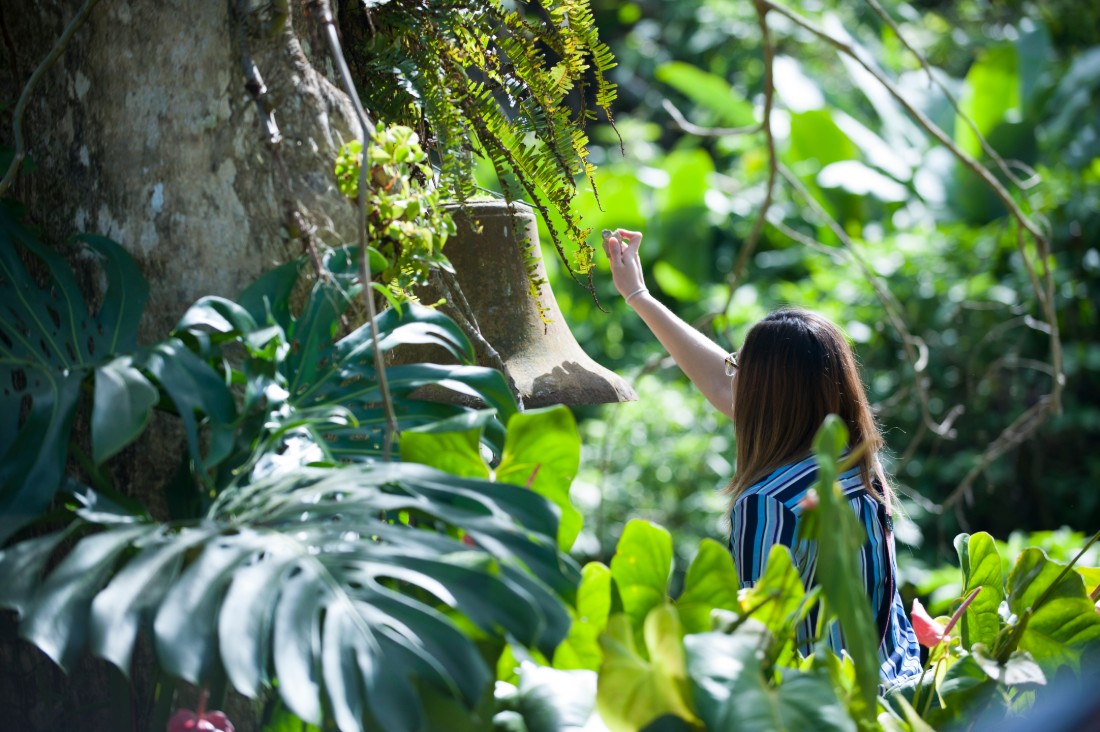In Puerto Rico, I learned that butterflies are more resilient than dinosaurs
By Justin Agrelo
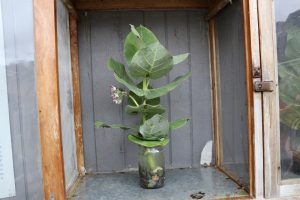
There’s a square in downtown Adjuntas, Puerto Rico that when standing inside of it feels like you’ve hopped into a postcard or a history book about Spanish colonization.
The square is paved in white cement and gray cobble. Its fountain, benches, and pillars are all polished in white. Small patches of vibrant, neatly trimmed grass break up the monotony of the space.
Colorful Spanish colonial buildings line the square and a mountain can be seen in the distance, just above the bell tower of the town’s central church.
The square and its surrounding streets are almost empty except for three older gentlemen. The men break from their conversation and coffee to examine our group of unfamiliar faces, standing not far from them with cameras around our necks and cell phones stretched out.
We’re standing at the square’s entrance at 6:30 am in early February. We’re here on a reporting trip. But maybe this is a list of projections from my own insecurities. Maybe the people of Adjuntas are used to unfamiliar faces walking around on an early Sunday morning in awe of everyday things like cement benches and palm trees.
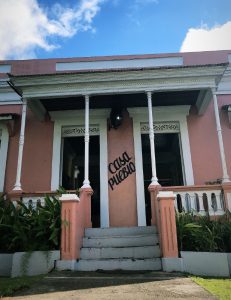
Because down the road from the town square is a small, pink house. This house has brought visitors from around the world to Adjuntas, including Congresswoman Nancy Pelosi. There’s a black sign on the front of the house that reads “Casa Pueblo” in thick cursive letters.
It’s hard to describe exactly what Casa Pueblo is outside of technicalities, having only spent a few hours there. Technically, I suppose, Casa Pueblo is a non-governmental, community watchdog organization that advocates for the transition from fossil fuels to clean, sustainable energy alternatives like solar, amongst other things. The place is powered entirely by solar energy and produces more power than it uses.
The organization has some big environmental wins under its belt, including one in 2012 against a government-backed pipeline that was supposed to stretch through 1,500 acres of rainforest.
Immediately after Hurricane Maria, Casa Pueblo became a lifeline for the community. It was the only place for miles with energy during one of the longest blackouts in history. And it’s because of this that makes it feel unfair to describe the community center by its technicalities.
We can count its legislative wins and the solar panels on its roof and the number of students who learn science at its rainforest school throughout the year. But how do you measure the comfort it provided people who felt cut off from a world that didn’t seem to care? How do you quantify the impact of hope?
When our group arrives, we’re given a presentation on Casa Pueblo’s history in its solar-powered movie theater by one of the founders, Don Alexis Massol. After the presentation, our tour guide, Rodrigo, shows us around the space. We’re taken through several classrooms. One with microscopes and fossilized butterflies. And another with drums and keyboards haphazardly placed throughout the space. Rodrigo tells us that the students at Casa Pueblo range from toddlers to seniors because learning is lifelong.
We’re then taken outside to a small greenhouse where we find more butterflies. Inside the small greenhouse, monarchs float about on this sunny Sunday morning. Rodrigo stops us in front of a case next to the greenhouse. He opens up the cabinet’s doors, revealing a litter of caterpillars and cocoons on a small plant inside.
Rodrigo explains to us that the butterfly is an important symbol for Casa Pueblo–a small organism with magical abilities so resilient that it outlasted dinosaurs.
We head to Casa Pueblo’s Rainforest School or Bosque Escuela La Olimpia for a few hours. We hike up a mountain, learning about the significance of caring for the earth. After several hours, we head back to the small pink house in Adjuntas.
Casa Pueblo is livelier now. Community members walk in and out of the space, smiling and laughing. In the gift shop, Casa Pueblo’s other founder, Señora Tinti Díaz, runs the register.
I pick up a small, gray coffee mug with a Taino symbol on the front. The line to check out is not long, but paying takes several minutes. Community members keep popping into the gift shop to greet Doña Tinti with a hug and a quick “how are?” which slows down the process. Each visitor takes the time to check in with her and share a laugh. I wonder if this is how to measure Casa Pueblo’s impact–by the hugs and the smiles and the laughs that radiate through its vibrant walls.
Coming Together in the Caño
By Noah Broder

As they stood by the edge of the Caño, or channel, the Medill students listened carefully to the stories of confusion and concern that many Puerto Rico residents felt after the hurricane. It was one thing for the students to read about people’s experiences and read about the community, but it was a whole other thing to hear in person about what people had to go through in this cluster of eight low-income neighborhoods around a polluted estuary on the edge of San Juan. The stories about the lack of communication, the lack of power and water, and the wondering about the safety of loved ones.
While it is sometimes difficult to hear about a past struggle and know that you were powerless to help in somebody’s time of need, the leaders of the bike tour we took through Caño Martin Pena still had a positive message for us journalists. The tour guides implored the students to cover the important stories and spread knowledge about what happened and what needs to happen on the island. The tour guides were proud of the progress that they had made on a community level, and they discussed the importance of community efforts to clean up and rebuild after Hurricane Maria. They wanted the journalists to focus on these community efforts and understand the process of rebuilding.
We learned about the environmental, social and political forces that were at play in the neighborhood; about the health of the water and efforts to clean up and clear garbage and restore water flow. We learned about the problems related to people dumping garbage in the community and how that affects daily life. We learned about the process of relocating people within the community without completely uprooting them, so that a restoration process can begin. The students learned about “the process before the process” and the importance of managing people and emotions before managing policies and procedures.
Through this experience, we asked important questions and tried to gain valuable perspective on the work that has been done and the work that is still to come. As we return to Chicago we will begin to tell the stories we explored in Puerto Rico, especially the stories like those at Caño Martin Pena of survival and working together in the days after the hurricane.
Artist-run space Beta Local keeps its doors open to Friday night in Old San Juan
By Camille Erickson
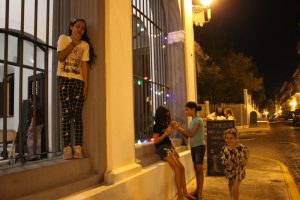
As the sun simmered on the horizon, chords of Puerto Rican salsa music and the scent of soup spilled out onto the cobbled-stone road. Rainbow holiday lights wrapped around the windows’ decorative rejas, or iron screens, beckoned residents to come inside the festive space.
It was dinnertime at Beta Local, an artist residency space in Old San Juan.
Every month, the organization hosts a meal for artists and community members to congregate. Beta Local launched a decade ago to provide Puerto Rican artists with a discursive space to experiment with and make contemporary art.
After Hurricane Maria, the organization relocated to its new space called Casa del Sargento on Calle Sol. They rent the historic building from the Institute of Puerto Rican Culture. Pedro Guardiola, one of three co-directors at Beta Local, said he waited over two months after the hurricane for electricity to return. He likes that the new space doesn’t rely as much on the fickle performance of the electric grid. Floor-to-ceiling colonial archways dominate the outer walls of the building, allowing generous goblets of light to flow in.
“During the day, you don’t need power to operate,” he said. “You just open the doors.”
For Friday night’s public meal, the three co-directors of Beta Local kept their doors wide open as they invited community members to donate funds to the space in exchange for a homemade meal and conversation.
This week, a neighbor who lives across the street made the fragrant pea soup. And inside Beta Local, the chatter of children bounced off the space’s vaulted ceilings. Drawings and poems littered the walls — evidence of artists at work. Lively conversation peppered the room as nourished guests formed intimate circles around unadorned tables. It was like the space hosted a half-dozen family dinners all at once.
This buzzing center for art and community represented just one pocket of the many thriving art scenes in Puerto Rico. But this moment at Beta Local also epitomized the resiliency of artists who have endured more than 18 months of post-hurricane recovery.
Nibia Pastrana is a choreographer who was a resident of Beta Local in 2015. She also invited me to the dinner and fondly considers Beta Local a central space “made by artists, for artists.”
But her sober words about the state of the arts in Puerto Rico captured the tension artists feel as they reckon with the political and economic realities of the island.
“I don’t want to frame the conversation around the hurricane,” she said, “but I think that after that we’re still dealing with some backlashes. I don’t see the future as something that promises stability for Puerto Rican [artists].”
When tragedy strikes or politicians hammer down austerity measures, artists often watch their budgets get slashed first. But this lack of stability does not mean a lack of creativity. Artists throughout the island remain resolute and continue not just making work, but also interrogating the continued colonization of their homeland and culture.
From Closed School to Community Center
By Clarissa Donnelly-DeRoven

On a hot and sunny Saturday morning in February, a handful of community members are scattered throughout the former Pedro G. Goyco school. They’re getting ready to power-wash the floors and cut the overgrown grass. A security guard reads a book as she sits outside the school’s main doors, and an older woman rests on a chair just inside. When we start to speak to her, she directs us towards “las jefas.”
Goyco is a massive yellow building that rises from behind a colorful gate painted with words like “justicia” and “responsabilidad.” It’s sandwiched between a half-demolished building and a mostly-outside restaurant that serves espresso and poke bowls. The former elementary school was shuttered, along with almost 100 others, during the first round of mass school closures in Puerto Rico back in 2015. Since then, a group of activists have been fighting to rescue the empty building by transforming it into a community arts and culture space.
We find las jefas, a group of women who look dressed to do some major cleaning. One of the bosses, Lydia Platon, comes to talk with us outside in the courtyard. Platon is a lifelong resident of the neighborhood. She points out her apartment as she speaks. “In the beginning, it was about saving the school, but not really,” she said. The principle goal, as Platon describes it, was to preserve the character of the neighborhood. “We need the building to not become a boutique hotel,” she said, adding that in their neighborhood, “There are no public spaces.”
The school sits on Calle Loiza, one of the main veins in San Juan’s rapidly changing Santurce neighborhood. When Platon was growing up, she remembers Calle Loiza as the place you’d go to get your first communion dress, to get your clothes tailored, to get a haircut– a place where the guy who owned the hardware store lived upstairs, a place where you could get a coffee for 50 cents. Some of the older businesses remain, but she said many also have been replaced with upscale galleries and restaurants. By turning the school into a community arts and culture space, “We’re trying to relive something that our street has lost.”
Before Hurricane Maria hit the island in September 2017, the activists had already begun the process of re-taking the school. Platon said they used the school for public meetings. After Maria, Platon said the school functioned as a distribution site where residents came to get critical supplies like water and food. From the school they also handed out donations various churches and synagogues in the neighborhood had received from the continental U.S.
Building Community with Bomba
By Dana Brozost-Kelleher

Sounds of rhythmic drumming waft through the open windows of Corporacion Piñones Se Integra or COPI. The vigorous drumming travels down the street in Loiza, Puerto Rico, attracting a crowd of people to the light-yellow community center.
Some peer in from the open windows while others pack into the back of the wooden dance hall to watch the group of women and young girls move in sync with the beat of the drums. Cruz Mari, a member of the COPI team, stands on the raised stage at the front of the room to teach the large group how to dance Bomba.
Developed in the 17th century under Spanish colonial rule, enslaved African workers on the island adopted the Bomba while working on plantations as a form of resistance and community. The dance involves several different rhythms that vary in intensity. Cruz Mari introduces and demonstrates each new rhythm for the class to model. Two male drummers sit on the stage on either side of her. They watch her intently, matching the speed and intensity of their drumming to her movements. The group works together to create a dialogue of sound and dance.
With looks of amusement and determination, the class moves their feet, hips, and arms in unison with Cruz Mari. They wear long, vibrant-colored skirts that decorate the air as they move. Each woman holds the end of the skirts in their hands, using the material to accentuate the movement of their bodies.
Cruz Mari forms the group of dancers into a circle and asks each person to step into the middle of the room to perform what they have learned. The youngest girls in the group volunteer to go first and dance with strong confidence. Their movements are quick and they each finish their turn smiling.
“Eso!” Cruz Mari yells joyfully, clapping her hands and dancing around the circle as each person takes a turn.
The class is a mix of tourists and members of the Loiza community. They have heard about the reoccurring weekend event through word of mouth or social media. “We want people to have fun, dance, and leave happy,” says Maricruz Rivera Clemente, the founder of COPI.
Rivera Clemente says COPI formed in response to the island’s systemic marginalization of black people and erasure of Afro-Caribbean communities and culture. Recognizing this deterioration in the African descendent municipality of Loiza, Rivera Clemente said COPI developed to improve the image and quality of life for black Puerto Ricans through the conservation and promotion of African culture.
Though initially the organization was only meant to serve the community, Rivera Clemente says that as it got bigger, it expanded to include visitors from outside the community as well. Citing the dire state of the local economy as the most pressing issue in Loiza, Rivera Clemente hopes that in allowing tourists “to learn about our community from its community,” positive attention will bring people and business back to the area.
Asking the forest for permission
By Becky Dernbach
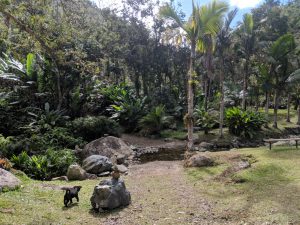
The Bosque Escuela, located on 150 acres of land tucked in the mountains of Puerto Rico, contains a series of open-air classrooms where students can learn about nature and the scientific process. (Katie Rice/MEDILL).
Rodrigo jiggled his key in the lock, and the metal gate swung open. Two small dogs crawled under the gate as he was working the lock, and we followed them through.
The gate opened into a lush basin, a flat grassy expanse surrounded on all sides by mountains cloaked in tropical greenery. We were tucked in among the mountains; the forest unfurled before us. Birds trilled cheerfully through the palm trees. We had arrived at Casa Pueblo’s Bosque Escuela, or Forest School.
“Okay, my people,” Rodrigo said, gathering us in a circle. “I need a volunteer.”
Rita stepped forward.
“Take a rock,” he invited her. “You’re going to that bell over there. You’re going to get close by, hit it three times.”
As Rita struck the bell, the sound resonated through the basin — at once a mountain school-bell and the beginning of a meditation.
We took a moment in silence before Rodrigo explained the ritual. “It’s because we are entering to a sacred place, a place where millions of species live,” he said. “I always say that when we hit the bell that’s our way of asking permission to enter the forest.”
Rodrigo led us to a set of narrow benches built into the slope of a hill and invited us to close our eyes for 10 seconds and observe the forest. Birds called merrily back and forth to each other. A river rushed ever forward. A breeze rustled through the greenery. A year and a half after Hurricane Maria, the forest has lost some trees yet still teems with lushness.
When we opened our eyes, Rodrigo told us the history of the school. The Bosque Escuela is a project of Casa Pueblo, an organization whose roots are in the struggle to protect land and water from open pit mining in the 1980s. After 15 years, Casa Pueblo won this fight. Its founder, Alexis Massol Gonzalez, was awarded the Goldman Prize in 2002. With funding from the prize, the organization was able to acquire some land and develop a forest school.
Students from elementary, middle and high school stop by weekly or monthly to put what they’ve been learning in the classroom into practice.
“The walls are nature, and the roof the sky,” Rodrigo said. With nature as their classroom, a new generation is learning to be stewards of the environment.
Inside the forest’s ‘Motivation Classroom’
By Katie Rice

Our guide opens the gate, and we walk into a clearing in the forest. This is the outdoor classroom for Casa Pueblo, a community self-sufficiency organization that lobbies for various environmental causes. To our left is a stream and an entrance to a forest that slopes gently uphill.
The dogs that have accompanied us into the area take off in that direction. Our group heads forward, toward an outdoor lecture hall of sorts. Here, wooden boards on an incline form rows of benches that face a lectern. The classroom is tucked away, surrounded on three sides by trees.
We’ve entered the “motivation classroom,” explains our guide from Casa Pueblo, Rodrigo Ortiz Figueroa, and it’s the first stop on our tour through the Bosque Escuela La Olimpia. The school is home to the headwater of the Río Grande de Arecibo, which provides potable water to over a million people in towns downstream. If you’ll pardon the cheesy comparison, the river seems a fitting analogy for the knowledge that trickles from instructors to students in La Olimpia.
“The students have the opportunity to learn in an environment where the walls are the nature, the wind, the river, the birds, the flowers and everything else; and the roof [is] the sky. Here, it is scientifically proven that students learn more in an environment like this,” explains Rodrigo.
His research is solid: various studies from the past 25 years have found evidence that providing students with a curriculum of outdoor learning helps them retain information and promotes the development of cognitive and social skills. Much of the research has focused on younger students.
I’d wager that most of us on this tour, graduate students in journalism visiting from a city where it’s probably snowing, have almost never attended class outside in our 15+ years of formal education. Even now, as we follow our guide through the forest, we’re fighting the elements — slathering ourselves in sunscreen and stepping downwind from the group to liberally spray mosquito repellant.
Rodrigo leads our group toward the other classrooms the forest holds — the watersheds classroom, the water treatment classroom and the geology and fungi classrooms. We learn about the forest’s function as a natural water purifier and observe how fungi break down waste. The forest offers the sort of curriculum a third-grade science class might study, and our group of adult students is enthralled.
“Each classroom has a special function that serves as a learning experience for the students that come — and for you guys!” Rodrigo exclaims, smiling. He leads the group further into the forest, no doubt talking about the values of an environmental education, but I can’t hear him. I’ve stepped off the path to scratch an angry red welt rising on my leg. Maybe I wasn’t cut out for a natural education after all.
La Ronda: ‘Always ask about the future, not the past’
By Chris Schulz
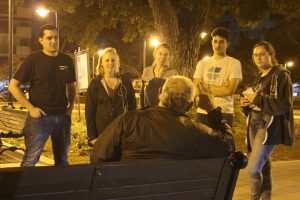
We’ve only made three stops when we roll up just out of reach of the overpass. There were lots of people at the last stop, but the first two were men, alone. One was so drunk we could barely understand what he was saying. The other was walking back and forth across a busy intersection, asking for change, desperate to buy the drug he couldn’t have for the last two days in the hospital. His leg is injured, but the withdrawal hurts more so he left the hospital.
It’s well past midnight but we’ve only been out for about two hours on one of Iniciativa Comunitaria’s nighttime street rounds.
There are many more people here. A group of about six or seven sit under a well-lit overhang across from where we park. Almost immediately a man, who I will later learn is named Javier, approaches us to exchange needles. I watch him put his used needles in the plastic hazmat box, and give him the corresponding number back. “Seis para seis” I say to him as I hand him the new needles. As we hand out coffees and food and condoms, Javier gestures to the group across the street. “El no puede caminar, pero tiene para cambiar.” His friend has needles to exchange but his leg is hurt and he can’t walk, so when he puts five more in the box, I hand him back five.

After a frenetic 10 minutes of handing out whatever is asked for, we prepare to leave but a call for “Cafe!” echoes across the street. Soon we’re all across the street, handing out socks and talking.
“Como lo han pasado?” I ask. “Bueeeeno” comes the simultaneous reply from Alessandra and Joel, laughing at a joke I’m not a part of. “Estamos bien” they assure me.
“Y que van a hacer mañana?” I ask them. This is more advice from Ivan: always ask about the future, not the past.
“Eso es lo que no queremos pensar,” Joel replies, growing serious. We don’t want to think about that. “No sabemos si vamos a tener un dia mas de vida, no podemos adelantar.”
“Que quisieras?” I press him.
“Yo quisiera que apareciera un ángel” he says, difficult to hear over the sounds of traffic and his partners talking all at once.
“Quisiera que amaneciera bien, te lo juro. Yo le orare a ese dios…que yo no piense mas en drogas. Que no piense mas en drogas y me sienta bien mi cuerpo. Que no me importe. Se que va a ser imposible pero…” he trails off.
We keep talking: about our route for the rest of the night, about rounds that have brought hot soup and new clothes in the past, about our futures.
“Algun dia podran notar la superación de algunos de nosotros,” says Joel when we explain our aspirations to be journalists.
“Si, en un nuevo dia” I say to him.
“No en El Nuevo Dia no! No me gusta ese periodico,” he replies sternly. We all laugh, sharing in his joke. We say our goodbyes, hand out a few more coffees, and move on.
There are still five hours left in our round.
Stripping life down to the basics
By Rita Oceguera

Ivan Figueroa comes in and out of the storage room, helping Ana round up some items she needs. Ana is outspoken — demanding, really — bossing around Kenneth Rivera, who willingly does whatever she says. She is not afraid to ask for what she needs and clearly feels comfortable inside the building. She is a regular. Emanuel Rivera, Kenneth’s older brother, speaks of her fondly, smiling as he watches her take over the space.
Ana is 50 years old and homeless. She has been coming to Iniciativa Comunitaria for years now. She grew up with a mother who used drugs and since the seventh grade she has used herself. She is both full of life and tired of it at the same time. Her body aches. There are days where she doesn’t sleep.
“Voy a cambiar pero no ha llegado el momento,” she says.
Ivana and Emanuel have volunteered at this organization for years. Like Ashley, Carly, Chris and I, Kenneth is experiencing “las rondas” for the first time. These nighttime rounds around various neighborhoods are a service the organization provides to bring some necessities for those who live on the street. Tonight the van holds coffee, juice, food, water, socks, hygiene kits, condoms and a needle exchange system for those who need it. Sometimes there is a medic who rides along. Not today. Today it is just four Medill journalists and two volunteers.
Before we hit the streets, Ivan and Emanuel tell us about the organization, their experiences and give helpful tips on how to best approach this community and learn about their lives.
Ivan explains that his experience helping these people has been transformative. He says he used to once love the rain, but not anymore. He recalls a moment four years ago during a rainy night.
“Me recuerdo y me da sentimiento,” he says.
During that ronda, Ivan approach a man who quickly told him to not get any closer to him. Ivan backed off and let the man calm down. He then approached him again. The man, now calmer, explained he was taking off his shoes when Ivan first approached him and that the smell was too bad.
Ivan remembers this moment so vividly because here was a man who was on the street, cold, wet from the rain but yet took into account how bad his feet and shoes must have smelt and didn’t want to attack Ivan with that odor.
The rain did not seem so beautiful anymore, knowing that it could be ruining the day of someone who has no shelter.
Ivan and Emanuel don’t see this organization as simply a way to provide services for those who are homeless, but to provide them with some humanity. They treat each person as their equal, taking the time to listen to them without judgement and treating them with dignity.
“Somos un gran abrazo,” Ivan says.
While the stories I learned from all the people I met that night will always be with me and their expressions are ingrained into my mind forever, Emanuel inspired me that night. He approached each person with kindness and an open mind and gave them something that can never be measured or taken away: his undivided attention.
Emanuel allowed them to express whatever they needed or whatever they wanted to say. He was patient, he was understanding, he was non-judgemental. Ivan said some participants go days without speaking to anyone and that the only conversation they have is with the Iniciativa team. Their job is not just to provide some necessities, but to create a moment where they feel valued as individual human beings — not bad people or drug addicts or sex workers. Such labels and stigmas just melt away as people talk with Emanuel.
He showed us that night how easy it is to embody humanity.
A long list of places to go
By Carly Graf

It’s around 4 a.m. when we turn a corner in our green minivan and immediately spot a woman waving at us to pull over. Emanuel, the driver and volunteer leader of tonight’s outing, parks on a street corner, and two women come rushing out from the shadows of a storefront porch. Natalia, dressed in a short jean skirt and blank tank top revealing a chronic skin rash, asks in a raspy voice for coffee, juice and an extra sandwich to take back to her friend. The other, clad in a mismatched sweatsuit and missing most of her teeth, brings over a handful of used needles she wishes to exchange for clean ones.
We’re with Iniciativa Comunitaria, a public health non-profit that works to provide resources and treatment to the homeless population in the San Juan metro area, many of whom are chronic users of drugs like heroin or methamphetamine. Tonight we’re participating in one of their Operation Compassion nighttime rounds, during which they give food and drink, medical supplies and prevention kits including items like condoms, clean syringes and other drug paraphernalia to anyone who approaches the van and asks for help.
“We humanize them and care for them without judgment,” said Ivan Figueroa, a pharmacist by day and volunteer who’s been working with the organization for over five years.
It’s part of a public health methodology called “harm reduction,” which seeks to improve quality of life for addicts, sex workers and the homeless and to prevent the spread of communicable disease like HIV or other STDs.
Earlier in the night, Emanuel spotted someone sifting through a garbage can. He pulled up and explained the van’s work. Shortly after, a few more people emerged from around the corner asking mainly for snacks, juice and feminine hygiene products.
One was a woman named Vicki, mother of seven who, among other things, took home two bags of condoms and three mini vanilla cupcakes.
“Be careful there,” she said, pointing straight ahead towards a bridge underpass. “There are lots of people.”
The decision to do this outreach at night is very deliberate, Emanuel explained. It’s in darkness that the addicts, homeless, sex workers, transgender people and other vulnerable people feel the safest. It’s called “la invisibilidad,” he said. The invisibility. By day, that means loneliness. But, by night, that means safety.
“We also go at night because we can achieve more intimacy and people are more likely to accept our help,” he said.
Back near the bridge, we come across a group of about 10 people, a mix of men and women, some more alert and coherent than others. After handing out the requisite assortment of needles, antiseptic wipes and coffee mixed with copious amounts of cream and sugar, a woman named Carolina started speaking animatedly about how she wants to get off the streets.
“My dream is to travel,” she said. “I have to make money but, when I do, I have a long list of places to go.”
‘No me falta nada’
By Ashley Hackett

Cars whiz by on the overpass above us as our dark green minivan pulls up to an encampment filled with tents, mattresses, and shanties. The driver, Emanuel Rivera, hops out first to check the scene for safety.
“Pueden bajar,” he tells us, and the five of us pile out of the van. We tentatively approach a small tent underneath an overpass.
“¡Hola!” Emanuel calls. “¿Quiere cafe, comida? Jeringuillas?” Do you want coffee, food? Needles?
“Si, comida y cafe,” a strained voice responds from inside the tent.
We’re with Iniciativa Comunitaria, a volunteer group that practices harm reduction in the streets of San Juan, Puerto Rico, and the surrounding areas. The group carries clean needles and bags of condoms in an effort to prevent the spread of illnesses like HIV, hepatitis, and other sexually or intravenously transmitted diseases. Iniciativa Comunitaria also puts together bags of food and water, and the volunteers pour fresh coffee and juice for anyone who might want it.
This particular tent holds a 77-year-old man named Carmelo Hernandez Hernandez. The night is warm, and he zips open his door to greet us with a smiling face of wrinkles and shirtless, tattooed chest. Carmelo is originally from Mexico, he tells us, though he’d been all over the United States before landing in Puerto Rico.
“Yo era coyote,” he tells us proudly. Carmelo spent years as a “coyote,” helping people get across the border from Mexico to the U.S. – he was mostly successful, and though police caught him a few times, they only arrested him twice.
“El coyote tiene que tener buena corazon, la responsabilidad,” Carmelo says. “Yo siempre respetaba a la gente que cruzó por aca.”
Though the U.S. government tends to demonize coyotes, Carmelo insists that he maintained a good heart, and always respected the people he helped find a life with more opportunity and less danger.
Emanuel hands Carmelo a sandwich and some coffee, but he’s more interested in the conversation.
“No me falta nada,” he says. Carmelo, living in this threadbare tent under an overpass, has everything he needs. He points to the sky: “Dios me cuida.” God takes care of me. At this point, I’m not sure if it’s my sleep-deprived mind making me overly emotional, or if Carmelo’s story is so touching, but I shed a few tears. I could learn a lot from Carmelo.
Before we leave, Carmelo wants to leave us with his own parting gift — a song you can hear here. Out of all the music he knows, he likes Mexican songs the best. They tell stories.

